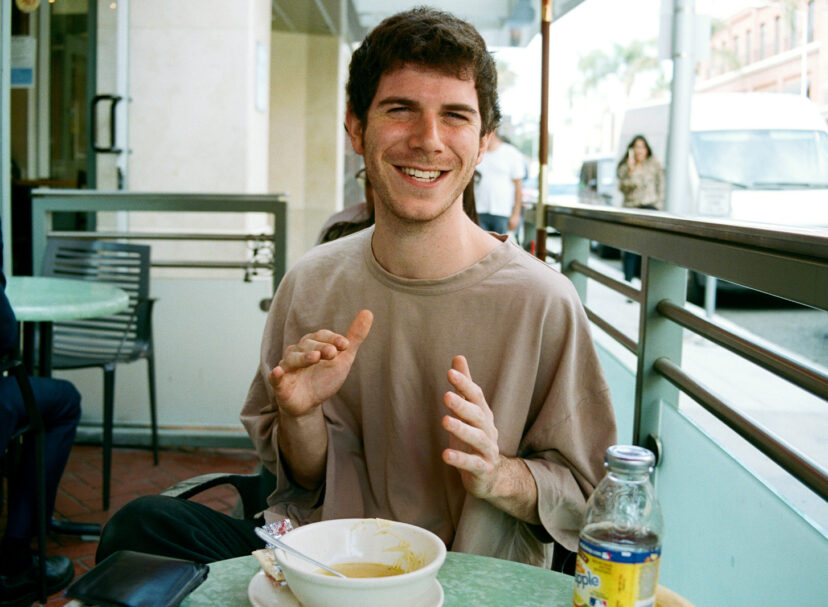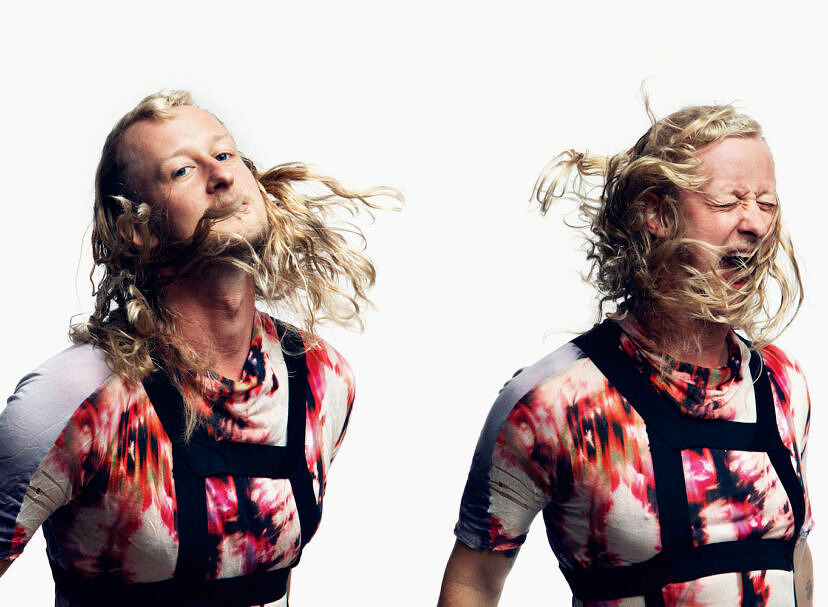Images: Terrorbird
Text and Interview: Paul Parreira
After reaching out to Keith Kenniff to set up a call to discuss the new Helios album, Yume, I heard back that he was also promoting Sometimes, an album release for the ambient, piano-based music that he creates under the name Goldmund. I was to choose which artist/album I’d like to write about. It’s not typical to hear about an artist promoting two albums at the same time, especially one juggling family life, a commercial music library, and various other projects. I decided to speak to Keith about both releases, out this month.
The music he creates as Goldmund is beautiful, expressive yet gentle. It’s his take on ambient solo piano sound. His playing seems to push the air around the room, and sometimes draws it in. On proper headphones or a nice system, you hear the breathing and creaking of the instruments. Or is that an effects unit creating static? The distant screams and sounds of a playground drift into “Getting Lighter,” one of the highlights, mixing with piano and other soft noise to create a delicate take on musique concréte. The writing is improvised, superb and simple, with flashes of Ryuichi Sakamoto, Jacaszek, Harold Budd, Nils Frahm, and Eluvium.
Helios, his more ambitious undertaking, cautiously but boldly leans towards the sound of indie electronic instrumental music. It’s very well crafted, almost obsessive in detail—think Boards of Canada wrestling with Tycho, peppered with tons of melody and rhythms. Every sound feels perfectly placed in the mix. This is soundtrack music, moody and energetic, high and low.
I found it interesting that he separates the two into different monikers. You would think it’s a philosophical approach, but really it’s just a practical, smart move, considering ritual and practice. Keith would sit at his piano after working on complex, multi-layered projects like Helios, and would wind down with the minimal piano playing that turned into Goldmund. We spoke via phone about his music, life and the hardships of being a musician in the digital age.

Where are you based?
Just outside of Portland, ME.
How is it up there?
Getting colder. Heading into winter.
Well, congratulations on the new records, plural. You must be busy?
I actually have another album coming out in February, too. I’m staggering all of the releases because we couldn’t release them all together.
I love your music, and I love the emergence of piano music at the crossroads of ambient and classical. You studied at Berklee, was it piano?
No. The only piano I took there was a requirement, an introductory piano course. I went there for drums–that was my focus the whole time I was there. And I just kind of played piano for ear training classes. They had these little practice rooms with a piano and I just started playing because I was stuck inside that room. I ended up really liking it. But I’m not a trained pianist at all.
The Goldmund album I listened to a lot is Two Point Discrimination. Is that the first Goldmund record?
No. That was the third.
Does the Goldmund sound tend to be more minimal than the Helios records?
Yeah. A lot of it is short piano pieces that are really simple and sparse. Part of that is just my technique, or lack of technique. I enjoyed it very much. Kinda like when you were a kid and you’re exploring an instrument for the first time and you come up with your own way of playing. It seemed really opposed to the way I was learning the drums which were very heavy, filled with teachers and books, everything was done very academically. The piano stuff was the complete opposite. I kinda liked how it was, no goals. I didn’t have to learn how to play a Bach piece.
I discovered your music around the same time as Eluvium. Do you know him?
Oh yeah. I know Matthew.
Again, I just love that sound—the lightness of the playing mixed with the heaviness of the mood. It’s just beautiful. Your playing falls nicely into that description. Is it all written out and then played? Or is it improvised?
I just record what I improvise. That’s basically it. I write and record at the same time. And a lot of the stuff on the new record was not set out for a collection of songs or even an album. It was just these little moments of time that I had between other work. It was a way to chill out, really. Playing the piano for a little bit. Turn the microphones on and then play, recorded over the course of a few years. That’s how it started out with the first album. I was just playing these pieces and shared it with a friend and then that friend started a label called Type and he convinced me to release it. It’s very haphazard.
You’re selling yourself a bit short.
Well, the other stuff I do is very thought out. I spend a lot of time writing and recording and shaping that sound.
I was actually planning on writing a piece on Helios. The new record is great. I have the previous release Eingya. That’s also a great record! And a great sound, reminds me of Labradford, Tycho, Boards of Canada, and other great post-rock—or whatever it’s called—bands. That merger of electronic processing and organic instruments is really interesting to me.
It’s all a mish-mash. I end up throwing it all into the computer. It all gets treated as electronic music the way I write it.
It’s great to hear that you’re comfortable with that. Some bands tries to hold on to this purist ethos—afraid of being too electronic, rock, or too much of one or the other.
It’s just easier for me to play on instruments rather than program it in. Then I go in and manipulate the sound. It’s just easier for me that way. And it’s more for fun for me.

Is Helios just you?
It’s just me. Yeah. And I record it all at my home studio.
So you don’t get to play the drums that often?
Ironically, no, I don’t get to play a lot of drums. While I was in college I thought, I’ll end being a session player, but after college I started writing music for commercials and it just called for me to play a lot of piano and keyboard stuff. I do play some drums on the Helios records, but it’s usually just for a minute, then I go in and chop it up to create loops.
And how did Ryuichi Sakamoto end up playing on “A Word I Give,” from the latest Goldmund release?
When the Japanese tsunami happened in 2011 hit, my wife and I did a benefit compilation so we asked him, as well as a bunch of other artists, to contribute music. And a friend introduced me to Harold Budd and Sakamoto for the compilation. And I just stayed in touch throughout the years and he mentioned that he knew my music. Then he was putting together a compilation for the same purpose to raise money for the victims of the tsunami and he suggested we do a track together. So I sent him this improvisation piece I had done and he added some ambient, textural stuff on it. It was strange to collaborate with him because I’ve been such a fan. It was great.
I saw him years ago (in the nineties) at the Knitting Factory when it was still on Franklin street. They had set up chairs in the venue facing the stage, that tiny little stage. It was so intimate. His playing was sublime.
Yeah. He came to a show of mine at LPR. He just kinda showed up and it made me so nervous for that show—just knowing he was in the audience.
Were you Helios that night or Goldmund?
I was Goldmund. I did just a solo piano.
So tell me about your third project, the Mint Juleps?
It’s a project that my wife and I are doing together. That’s coming out in February. It’s really different stuff. It’s much more poppy. Holly is right up front. It still has some ambient quality to it, kind of like M83.
Are you gonna be touring the Helios album?
No. I have three kids, plus a pretty busy work life. I was thinking about doing a couple of shows but the Helios stuff is really hard to pull off live. I don’t want it to be just me standing in front of a computer. I do like doing the piano shows it’s a bit more wide open and easier in a way, plus I can prepare for it.
I’m curious and the Unseen music library you’ve built to license music out for commercial purposes. That’s really smart! I know and speak to so many musicians who are struggling to pay the bills.
I think the tough thing is that even if I was touring a bunch with both Helios and Goldmund, it would still be really tough, especially for me because the music is so niche. It’s a lot of hard work. I know musicians who have families and they’re away for months at a time.
It’s nice that you’re comfortable with working on commercial music while maintaining these “serious” releases. Nowadays you either have to tour a lot, play the social media hype game or you have to write a hit song.
Right. It’s either that or you do your music and you have another career. You wanna have a career in music you’re gonna have to treat it right, no one it is going to pay you to do whatever you want. A few people can do that but it’s really rare. I do know a few musicians who feel that doing music for ads is selling out.
I read a lot of music bios and I constantly read about how when they were starting out they were “working” musicians. Sometimes doing 2 shows a day, touring relentlessly to get paid a small amount of money and a place to sleep. People seem to think being a musician means celebrity, and fame.
I come from a background where my dad was a musician, but he had to run our family business too. I mean, it’s just a job. People do all kinds of jobs. It’s a career.



